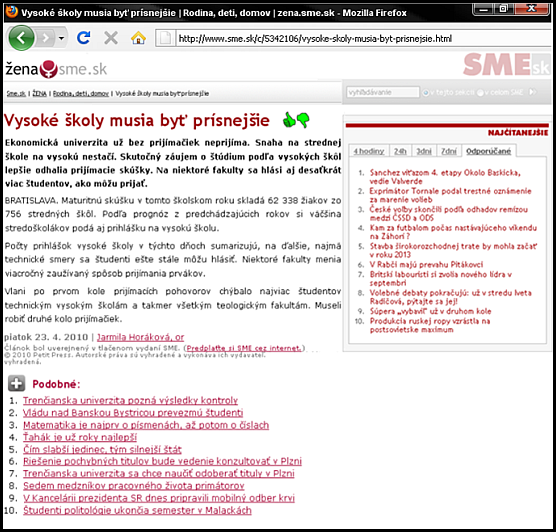|
Recommending Based on Similarity Relations Dušan Zeleník Master thesis project supervised by prof. Mária Bieliková |
Motivation
When readers search for an article, they would like to find something what is new, unknown but interesting. Many recommending systems use user preferences to generate suggestions. Our motivation is to automatically extract preferences using logs and use them to recommend appropriate articles in news portal. We wanted to focus on both content and time relevancy. Our content based recommender is then able to suggest articles, which are new, uknown and interesting for specific user.Method
Our method could be understood as two separated abilities of the recommender.- find similar articles using content of the article
- find interesting articles using logs of the user activity
Readers are monitored using action logging. Everytime user displays an article, system stores this action. Actions represents the interest of specific user. We are able to map each article displayed by the user onto nodes in the hierarchy. User normally reads articles which are close. Majority of articles are similar in the fact. This is how we locate interests which were covered. Other articles, which could be interesting are stored nearby in the hierarchy. Method is used to pick few of articles, which are sorted using time relevancy.
Evaluation
There are more methods how to evaluate our recommender and its abilities. We can evaluate similar article finder and recommender itself separately to show partial success.We used brute force method which searches for similar articles in our dataset by comparing each article with the rest. We used the same comparation, but in our hierarchical approach. Results were both mathematically and experimentally better in our case (logarithmical vs. linear).
To evaluate recommender and quality of recommendations we chose two alternatives.
- real usage of the recommender and feedback
- simulated usage and comparison with real reading

Publications
- Zeleník, D.
- Recommending Based on Similarity Relations. Master thesis, Slovak University of Technology in Bratislava 2010. 51p.
 pdf (in Slovak)
pdf (in Slovak)
- Zeleník, D., Bieliková M.
- Dynamics in Hierarchical News Classification. In Proc. of Workshop on Intelligent and Knowledge Oriented Technologies - WIKT 2009, Herľany, Slovakia, pp.83-87. (In Slovak)
- Zeleník, D.
- Representing Similarity for News Recommending. In Proc. of Student Research conference - IIT.SRC 2010, M. Bieliková (Ed.), Bratislava, Slovakia, 2010, pp.114-121.
| to Homepage | to Teaching | to the Top |
|
||
|
||